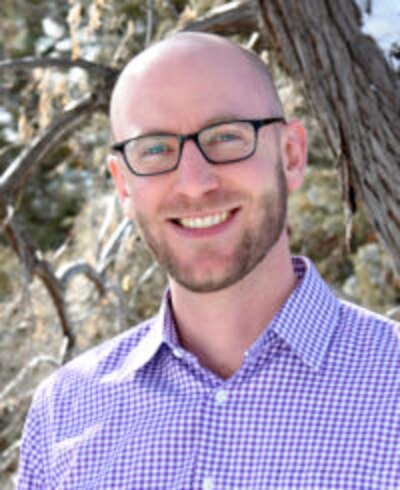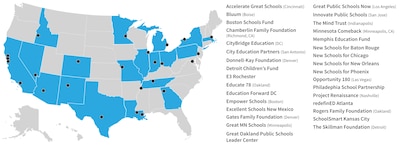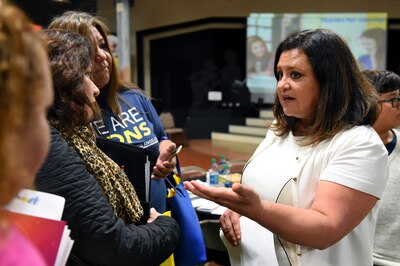Several years ago, Indianapolis Public Schools looked like a lot of urban school districts. The vast majority of students attended traditional public schools, though enrollment was dwindling, and the district had an adversarial relationship with its small but growing number of charter schools.
That’s no longer true. The district is actively turning over schools to charter operators, and it’s rolling out a common enrollment system for district and charter schools that could make it easier for charters to grow. Nearly half of the district’s students now attend charters or district schools with charter-like freedoms.
It’s a remarkable shift that many in Indianapolis credit to — or blame on — the Mind Trust, a well-funded local nonprofit with a clear vision for improving education in Indianapolis.
Since its founding in 2006, the organization has called for dramatic changes to schools; recruited outside advocacy, teacher training, and charter groups; and spent millions to help launch new charter and district schools. The Mind Trust’s vision has also won support from the school board — which was elected with the financial backing of Stand for Children, an advocacy group recruited by the Mind Trust.
“They’re more influential than the IPS school board and the IPS superintendent,” said MaryAnn Schlegel Ruegger, an Indianapolis public schools advocate who has been critical of the Mind Trust’s role.
Now, a Mind Trust–style organization may be coming to a city near you.
A growing number of philanthropists, advocates, and policymakers say the way to improve schools is to upend the traditional school district. Usually pointing to the same cities as models — Indianapolis, along with Denver, New Orleans, and Washington D.C. — they want to see more charter schools and more district schools run like charter schools.
In their idealized vision, families are free to choose schools outside their neighborhood using an enrollment system encompassing all schools. The district gives up most of its traditional role setting policy for schools and instead becomes the body holding all kinds of schools accountable by closing ones that don’t succeed.
Together, those ideas make up what’s known as the “portfolio model” for managing schools, and its advocates are making a significant mark on a number of American school districts. Their sights are set on even more.
From Atlanta to Cincinnati to Oakland, a loosely connected network of nonprofit groups is working to reshape the way their school districts function. Their national scope has gone mostly unexamined, even as their influence is arguably far more likely to affect schools in the average American city than a Betsy DeVos-inspired voucher program.
Over time, something close to a playbook has emerged from their work. It’s not an exact sequence, and people within the same camp have different opinions about exactly what it should entail.
This is a look at how we got here, a few of the essential steps to reshaping a traditional school district, and what happens next.
A model emerges: Dozens of cities and millions in support
To understand the growing movement, a good place to start is with Ethan Gray and his organization, Education Cities.
The group started as a project of the Mind Trust, which hired Gray to create a network of peer groups across the country. Gray says his views were deeply influenced by the Mind Trust’s founder and leader David Harris, who helped him “understand how all the different pieces fit together when you’re trying to catalyze major change at the city level.”

“Give us the freedom from overly prescriptive regulation and micromanagement, and in turn we will promise to help kids achieve on assessments at a certain level and create a strong school culture,” said Gray, who believes the traditional district model has fallen short, pointing to low test scores and vast achievement gaps.
Those ideas came originally from the academic world, specifically the University of Washington, where a professor named Paul Hill founded the Center on Reinventing Public Education in 1993. There, Hill pushed the idea that the key to improving schools was to rethink school boards.
Instead of operating all schools, boards should oversee them, focusing on which ones do best and worst, he argued. “Like investors with diversified portfolios of stocks and bonds, school boards would closely manage their community’s portfolio of educational service offerings, divesting less productive schools and adding more promising ones,” Hill wrote more than a decade ago.
The stock-market imagery was not a stroke of marketing genius when it came to winning allies in public education, and some advocates still bristle at the term “portfolio.”
“Diane Ravitch and the teachers unions now call us ‘corporate reformers’ and the phrase ‘portfolio model’ plays right into their hands,” said David Osborne, the author of a recent book that rebrands the approach as the “21st century schools” model.
Some charter critics accuse the portfolio model of being a plan to turn all schools into charters, as essentially happened in New Orleans, one of the models for the movement. Osborne argues that districts shouldn’t run schools, instead leaving that to outside groups. Gray insists it can work with district schools, and already is in Denver and Indianapolis.
But even as portfolio advocates differ on some specifics, they are united by broad beliefs, and brought together by unifying hubs. CRPE, the think tank now led by Robin Lake, regularly gathers districts interested in the portfolio model, and Education Cities, which has helped start some of the nonprofit groups, convenes them and offers advice and consulting.
Their work spans the country. Education Cities now counts 32 separate member organizations in 25 cities. So while Gray’s group itself is moderately sized, with around a $2 million budget and a dozen staff members, the ecosystem of independent local groups being built around its ideas is much larger in scope.
Education Cities member groups span the country

Member groups exist in three cities often promoted as models: in Indianapolis, it’s the Mind Trust. In New Orleans, it’s New Schools for New Orleans. Denver — a district with a self-described portfolio-management team — has two local philanthropies in the Education Cities network, and a new organization recently opened there that Gray says he helped advise.
Potentially representing the next wave of the movement, other member groups operate in cities like Kansas City, Philadelphia, and Oakland, which have not generally embraced the portfolio model.
Those organizations, which Gray calls “quarterbacks,” distribute money to get the portfolio approach off the ground in their cities — supporting schools seen as successful (often both charter and district schools), pushing for policies like common enrollment, and recruiting national education groups like Teach for America, Relay Graduate School of Education, TNTP, and Stand For Children.
Exactly how much money has flowed to support the portfolio model across the country is unclear. But prominent philanthropies, including some that have also spent millions in recent years funding charter schools nationwide, are investing heavily.
Education Cities is supported by a number of them, including the Dell and Walton foundations, as is CRPE. (Walton also supports Chalkbeat. Read more about our funding here.)
Many of the member groups are headed by former charter leaders and receive money from those national foundations, who see their investments as creating proof points that could become models for other cities. The Mind Trust, for instance, says it has raised $77 million since its inception in 2006, the bulk of which cames from local donors and a third from national groups.
The philanthropy that has most clearly embraced the portfolio model is the Arnold Foundation, whose K-12 education work is now led by Neerav Kingsland, the former head of New Schools for New Orleans. The Arnold Foundation has awarded a nearly $2 million grant to Education Cities and millions more to a handful of local quarterback groups, including the Mind Trust.
“If The Mind Trust can help to produce … gains in Indianapolis, the city can serve as a model for other communities across the nation,” John Arnold said in a video explaining his foundation’s investments.
But Education Cities operates on the principle that good ideas alone won’t reshape districts.
“We’re skeptical that systems themselves will actually go through some sort of self-driven transformation,” Gray says.
That’s where the nonprofit “quarterbacks” and their allies come in. They have varying perspectives and priorities, and there isn’t a set sequence of actions that they all take. But for simplicity’s sake, here are three common pieces of their strategy.
Strategy #1: Apply outside pressure.
Rather than waiting for districts to improve their schools, the groups pressure them to change course by directly supporting schools they see as effective and by creating new schools altogether.
The Mind Trust, for instance, partners with Indianapolis Public Schools to help select, fund, and launch new innovation schools. Those schools are run by outside operators, not unionized, and free from district rules around things like teacher pay or length of the school day, though they are officially counted as district schools.
The Philadelphia Schools Partnership, an Education Cities group, funded the opening of five new schools (four charters and one district-run) last school year. Great Public Schools Now, a Los Angeles-based group, pledged nearly $4 million to expand five district schools and has helped pay for a charter school’s new building.
In other cases, that means inviting charter operators to include the local market in their expansion plans, like when the Mind Trust tried to bring the Rocketship charter school network to Indianapolis, though ultimately no Rocketship schools opened there.
The idea is that with new, high-quality schools attracting local students, school districts may have to close their lowest-performing schools to stay solvent — a process some see as a feature, not a bug.

“To the extent that our expansion creates the urgent need for [district] realignment and closures, I think we would be very supportive of that,” said Myrna Castrejón, the head of Great Public Schools Now.
“We believe strongly [that] schools shouldn’t have an automatic right to taxpayer resources in the absence of effectiveness,” said Mark Gleason, the head of the Philadelphia School Partnership.
Advocates for the idea of opening new schools and closing others based on performance often point to New Orleans, where the school district was dismantled after Hurricane Katrina in 2005 and has been almost completely replaced by charter schools. Charters there are largely free to operate as their leaders see fit, but their student performance is monitored, and a number have been closed for low test scores.
Test scores have improved dramatically across New Orleans in the years since, though some of those gains appear to have faded recently. Research found a substantial chunk of the improvements came from closing or replacing existing schools.
But the success of school closures or takeovers is far from guaranteed.
Students’ new schools are not necessarily better; for instance, the Achievement School District in Tennessee, which had charter operators take over district schools and has been praised as a leader in implementing the portfolio model, did not improve test scores.
Districts also don’t always close schools quickly, resulting in students and resources being spread thin across all schools. And when they do shutter schools, communities often resist, worrying about the loss of a local institution.
“I’m concerned about the number and burden of closures on particular communities,” said Terrenda White, a professor at the University of Colorado who has questioned the success of Denver’s school reforms. “That means more risk for displacement of kids and teachers.”
Strategy #2: Push for one-stop school enrollment.
Another piece of the portfolio playbook is supporting enrollment systems that allow families to easily choose among district and charter schools.
Adding new schools and new choices can make things harder on parents, who must navigate several enrollment processes to make a choice and get assigned to a school. Common enrollment systems create a single place to navigate it all — while also ensuring that all parents are exposed to new schools, and making it especially clear to district leaders which schools are attracting the fewest students.
“In addition to efficiency for families, unified enrollment helps the system make better decisions about which schools to replicate, recruit, incubate, scale, and maximize and, perhaps, where to locate them,” according to an Education Cities report.
Denver, New Orleans, and Washington D.C. all have common enrollment systems, and Indianapolis just adopted one. In Denver, the use of a streamlined system did in fact increase enrollment in charters among low-income students and English-language learners, though in New Orleans parents said it was actually harder to navigate initially.
"We believe strongly schools shouldn’t have an automatic right to taxpayer resources in the absence of effectiveness."
Mark Gleason, Philadelphia School Partnership
In places where this system doesn’t exist, Education Cities groups are often pushing for it.
The Philadelphia Schools Partnership created a detailed plan to unify enrollment in the city’s district, charter and private schools, though the idea hasn’t taken off. Oakland-based Educate78 also spearheaded an ultimately unsuccessful effort to create a common system for district and charter schools with a $300,000 grant. The head of SchoolSmartKC, a Kansas City group, has testified before the state legislature in favor of a unified system, though the district’s superintendent says he’s skeptical.
While charter critics see the approach as a veiled effort to expand charters, centralized systems like this have also drawn another surprising adversary: more conservative supporters of school choice.
These free-market charter supporters fear that a single entity — a portfolio manager — with the power to manage enrollment and choose which schools to open and close would actually limit choice, put too much focus on test scores, and risk allowing unions to wrest control of the entire apparatus.
In fact, in 2016 it was Betsy DeVos, now the U.S. Secretary of Education, who was the key opponent of a plan to create a commission to act like a portfolio manager in Detroit, an effort spearheaded by an Education Cities member group in the city.
Strategy #3: Create a very different power structure.
Outside groups like the Education Cities quarterbacks can only do so much to implement this vision.
To see it brought to life requires the buy-in of the school board, mayor, or state — whoever runs the schools. That’s why the portfolio approach has gained particular traction in districts where states have taken over the schools, including New Orleans, Newark, and Lawrence, Massachusetts.
In other instances, supporters of charter schools have pushed change in school districts by working to fill local school boards with people sympathetic to the portfolio model.
Indianapolis is a case in point. The Mind Trust recruited Stand For Children, an advocacy organization that supports political candidates. In the 2012 election, Stand-endorsed candidates shifted control of the school board.
The organization doesn’t have to disclose how much it spent to support school board members in the city, but Stand for Children’s annual report says that in 2012, it “help[ed] elect two new members to the Indianapolis Public Schools board, which [led] to the exit of an ineffective superintendent.” The report also claims credit for school board victories in 2014 and 2016.
The capture of the school board cleared the way for many subsequent changes, including the hiring of a superintendent Lewis Ferebee who has supported a portfolio vision of the school district.
“If you look at Indianapolis, there’s no way to implement the vision without democratically controlled support,” Gray said.
School boards favorable to a portfolio-aligned vision have also been elected in Denver and more recently in Los Angeles, with financial backing from wealthy advocates of charter schools. Those charter school supporters have matched and sometimes exceeded spending by unions in a number of school board races previously dominated by teachers groups.
The portfolio model undercuts the unions and associations that represent teachers in other ways. The biggest is by reducing the number of schools whose teachers belong to the union, diminishing the union’s membership — and thus its power and its money.
The degree to which this is true depends on the political climate: in Indianapolis, innovation network schools are not under the district’s collective bargaining agreement, and thus lose certain job protections. Denver’s innovation schools can waive certain parts of the union contract, though teachers can still choose to join the union.
But most charter schools are not unionized. In New Orleans, soon after Hurricane Katrina teachers in the existing district were unilaterally fired, gutting the United Teachers of New Orleans, which has since organized at a handful of charters.
To some advocates, the reduction in union strength is integral to the model. They see an entrenched bureaucracy, maintained by “adult interests” — usually code for teachers unions — as the problem, and the portfolio vision as the solution.
“More than any other single reform this model breaks the political stranglehold interest groups have over elected school boards,” writes Osborne in his book “Reinventing America’s Schools.” (Osborne recently compared teachers unions’ opposition to charter school expansion in Massachusetts to George Wallace’s promotion of mandated school segregation.) Osborne’s work has been funded by prominent philanthropic supporters of charter schools and the portfolio model: the Arnold, Broad, and Walton foundations.
Some worry about the role of philanthropy, big-money donors, and state takeovers as undermining local, democratic control.
"We’re skeptical that systems themselves will actually go through some sort of self-driven transformation."
Ethan Gray, Education Cities
“As elected school board members, once our term is up, we come back up for consideration,” said Jennifer Wolfsie, a school board member in Kansas City. “If the constituents I serve are not happy they have the opportunity … to vote me out,” she said. “In philanthropy, there isn’t that process.”
Huriya Jabbar, a professor at the University of Texas at Austin who has studied New Orleans schools post-Katrina, acknowledges the large test-score gains in the city as a result of the reforms. But, she said, that came with a cost: community buy-in, in the wake of the mass dismissal of New Orleans’ largely black teaching force and the state takeover of most of the city schools.
“Even advocates of the reforms have acknowledged that the one thing they got wrong was community,” Jabbar said. “And I think of that as quite a big thing.”
The future: The portfolio idea in the DeVos era
Exactly how far these groups will be able to push their school districts toward a new way of running its schools is unclear. Few places are like Indianapolis or Denver, with strong political support for the model — and New Orleans’ hurricane-induced changes make it entirely unique.
New quarterback-style groups have continued to emerge, including ones recently formed in Atlanta, Denver, Kansas City, and Memphis. But other Education Cities members have faced setbacks.
In Nashville, the group Project Renaissance recently scaled back its operations, and despite heavy involvement from Stand for Children, charter skeptics maintained control of the school board in elections last year. A Detroit group also recently closed down, though the Skillman Foundation there remains an Education Cities member.
One place where there is no Education Cities group: New York City, which under former Mayor Michael Bloomberg was held up as a model by portfolio advocates like Paul Hill. That approach was substantially altered by Bloomberg’s replacement, Bill de Blasio, who has been cool to charters, slowed school closures, and reduced principals’ autonomy.
These setbacks underscore the challenges portfolio advocates will face in advancing their vision. Even its supporters disagree on a number of points — how clear their case is for a nationwide expansion, what strategies to pursue, and whether the model can work for district-run schools.
Meanwhile, the effort comes in a perilous time for charter school supporters, as nationwide support has dropped and they have become linked to an unpopular president and education secretary.
But for left-of-center charter backers, the portfolio approach presents an opportunity to position their brand of school choice as distinct from DeVos and other conservatives, who emphasize private school vouchers and want few limits on parent choice.
“Our model is probably different from the model of the [Trump] administration, and it’s not the same model of, if you would, a traditional school district,” said Henderson Lewis Jr., the head of the district that oversees New Orleans charters, in a recent interview. “We’re somewhere in the middle, which I see as a third way.”
This is part one of a three-part series. Part two takes a closer look at how the portfolio movement has played out in one city; the third part examines what research says about this emerging strategy.
Want more from Chalkbeat today? Sign up for our new national newsletter here.


